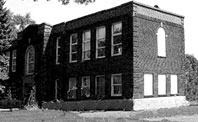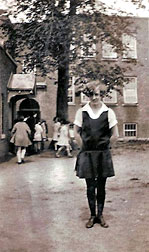Lorne Perry has contributed a series of articles about Depression, War and Recovery in St.Lambert in the 30's and 40's.
In the afternoon from three to four there were four 15-minute soap operas; “Life can be beautiful”, “Dr. Brent, Call Surgery”, “Ma Perkins” and “Pepper Young's family”. Whenever I was home from school with a cold, for which ailment I seemed to have a great attraction, I listened to these with my mother. They were pretty low key. Both parents enjoyed some of the evening programs such as Fibber McGee and Molly, Jack Benny, Amos & Andy, Lum and Abner (“Jottem Down Store & Library, Abner Peabody doin' the talkin'”).

We also had a big old wind-up Victrola that played 78 rpm records. My Mom liked waltzes, classics and Harry Lauder, a Scottish balladeer. Part of her Scots heritage I guess. My dad liked military marches. I can still play some of those old records from beginning to end in my head.
Education. My first school experience was attending Mrs. Welch's private kindergarten. I started when I was four, almost five, and I think there were about a dozen kids from the general area. I continued there two years until I was eligible for Grade 1. My mid-November birth date had put me back almost a year, but I was pretty shy, and two years of kindergarten was probably good for me. A private kindergarten was the only thing at the time, but three years later my brother (Brian) began school in the first kindergarten under the St.Lambert School Board.
Mrs. Welch was an early-retired teacher recently off the boat from England. Her conservative English methods, songs and poems were outdated even then but we students didn't know the difference. My only complaint was that I never got to play the triangle in rhythm band. This problem was rectified on my 70th birthday when my daughters gave me a shiny chrome triangle as one of my presents. The school, in the Welch home, was located right near the station and the trains starting up often interfered temporarily with serious education.

Real school in September 1938 began with a ten-minute stroll to Victoria Park School. We soon figured out that the shortest route was through back yards and across a tennis court. The school had just two classrooms above two gyms, accommodating grades 1 through 4. Miss Pollock handled the two lower grades with aplomb, while Miss Gallant looked after the other two. There was an identical feeder school on the other side of town.
Reading began in grade 1 with the aid of a giant Dick, Jane, Sally and Spot book that hung from hooks at the top of the blackboard. “Dick, See Dick. See Dick Run. Run Dick, Run”. We learned by the phonetic method and it seemed to work. Once I could read a little bit, my favourite book was Plum to Plum Jam, the story about taking plums from the orchard, through the whole transport and manufacturing process, to the kitchen table. I liked the orderly sequence of events leading to a familiar end product. I still have a book from that era that my parents gave me, “The book of splendid trains”. With that title, it had to be from England!
Up until about 1942 we used to get children's papers from England weekly. “Tiny Tots” and “Tiger Tim's”. They featured comics and stories. To conserve paper they were combined as the war produced scarcity, and then we stopped getting them as demand for military transport grew.
By the time I graduated to grade three, Miss Elsie McIvor was in charge, and she was a lady who took a real interest in getting me out of my extreme shyness. She encouraged my keen interest in drawing, named me as editor-in-chief of the class newspaper and otherwise had me participating beyond my inclination. The newspaper was hand drawn and written with a stylus on masters that were then reproduced on an early flatbed “jelly board” one sheet at a time. The ink was kind of purple and the printing became fainter as the press run ran on. But we had a newspaper with sports column, joke page, class news, nature column and a poem by a student. Everyone got to take a copy home.
I was given the job of decorating the frieze along the top part of the blackboard with transportation objects (trains, planes, ships, automobiles, trucks). It was a special privilege to use coloured chalk for this monumental, if transitory, work of art. Certainly WW2 fighter planes figured amongst the aircraft portrayed.

Miss Phyllis Powell arrived twice a week for gym classes. She was the first person I knew with a hearing aid. When demonstrating exercises she made clearly audible grunting noises, which I guess she didn't hear.
Field trips were not part of the scene, but we did go outside in the spring for art classes, drawing what we saw around us; the school, a tree, a flower, etc.
Several of my early fellow students stayed with me right through to high school, and one in my Grade 1 class became my employee at CN in the 80's, Keith Nelson Strike.
